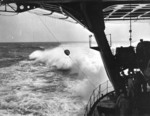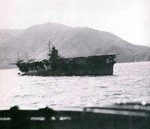Soryu
| Country | Japan |
| Ship Class | Soryu-class Aircraft Carrier |
| Builder | Kure Naval Arsenal |
| Laid Down | 20 Nov 1934 |
| Launched | 23 Dec 1935 |
| Commissioned | 29 Dec 1937 |
| Sunk | 4 Jun 1942 |
| Displacement | 15,900 tons standard; 18,800 tons full |
| Length | 746 feet |
| Beam | 70 feet |
| Draft | 25 feet |
| Machinery | 8 Kampon boilers, 4 sets geared turbines, 4 shafts |
| Bunkerage | 3,670t oil, 15,000gal aviation fuel |
| Power Output | 152,000 shaft horsepower |
| Speed | 34 knots |
| Range | 7,750 at 18 knots |
| Crew | 1,103 |
| Armament | 12x5in, 28x25mm anti-aircraft |
| Armor | 1.8in belt, 1in deck, 2.2in magazines |
| Aircraft | 63 operational, 8 in reserve |
| Flight Deck | 711.5 ft x 85.3 ft |
| Arrester Wires | 9 |
| Elevators | 3 |
| Hangar Decks | 2 |
Contributor: C. Peter Chen
ww2dbaseSoryu was launched from Kure, Japan in Dec 1937. As the lead ship of her class of fleet carriers, she was built around a sleek cruiser-style hull and powerful engines, enabling her to outrun the carrier Kaga at only about 40% power. In fact, at the time of her launch, Soryu was the fastest aircraft carrier in the world. She participated in many early Pacific War battles as one of the main fleet carriers of Vice Admiral Chuichi Nagumo's Mobile Force, including the attack on Pearl Harbor. During the Battle of Midway, her aircraft were responsible for attacking the Midway islands, and was caught by American carrier Yorktown's SBD Dauntless aircraft as her own were caught in the middle of refueling and rearming. Commander Hisashi Ohara, the Soryu's executive officer, just received the reports that Soryu's attack aircraft were ready to be launched when the American dive bombers were spotted. By then, it was already too late. He recalled:
ww2dbaseNot unlike other unfortunate ships that fell victim in naval engagements, the boiler room was often the most dangerous place to be. The seamen who worked in Soryu's boiler room were literally cooked alive by steam when the pipes bursted from the pressure of the explosions, which also immediately rendered the ship immobile. Despite the raging fires after receiving three direct bomb hits (first through the flight deck, second near the forward elevator, three near the after elevator), the watertight hull of the carrier remained in tact, therefore had she been left alone, she would remain afloat indefinitely. At 1045, abandon ship order was given, but the hull continued to hold the ship together. No official records exist as to what contributed to her ultimate sinking, but Ohara and other survivors noted a possible torpedo hit around 1915 that day. That torpedo possibly originated from a friendly destroyer that began scuttling Soryu prematurely. After the battle Nagumo claimed that Soryu sank from battle damage; it was likely that he provided altered information in order to save the face of the task force.
ww2dbaseSources: Interrogations of Japanese Officials, Midway Dauntless Victory, the Pacific Campaign, Shattered Sword, US Navy Naval Historical Center..
Last Major Revision: Sep 2008
Aircraft Carrier Soryu Interactive Map
Photographs
 |  |  |  |
Soryu Operational Timeline
| 29 Dec 1937 | Soryu was commissioned into service. |
| 26 Nov 1941 | Vice Admiral Chuichi Nagumo led the Japanese Carrier Division 1 (Akagi and Kaga), Carrier Division 2 (Hiryu and Soryu), Carrier Division 5 (Shokaku and Zuikaku), first section of Battleship Division 3 (Hiei and Kirishima), Cruiser Division 8 (Tone and Chikuma), Destroyer Squadron 1, Destroyer Squadron 17, and Destroyer Squadron 18 out of Hitokappu Bay in the Kurile Islands for the Hawaii Operation, the attack on the US Pacific Fleet at Pearl Harbor, US Territory of Hawaii. |
| 12 Jan 1942 | Hiryu, Soryu, Ariake, and Yugure departed Hashirijima in Hiroshima Bay, Japan. |
| 17 Jan 1942 | Hiryu, Soryu, Ariake, and Yugure arrived at Palau, Caroline Islands at 1140 hours. |
| 21 Jan 1942 | Hiryu, Soryu, Ariake, Yugure, Ushio, and Sazanami departed Palau, Caroline Islands at 1600 hours for air strikes on Maluku Islands, Dutch East Indies. |
| 26 Mar 1942 | Vice Admiral Chuichi Nagumo's Japanese First Air Fleet, built around a nucleus of five aircraft carriers (Akagi, Hiryu, Soryu, Shokaku, and Zuikaku), and supported by battleships (Kongo, Hiei, Haruna, and Kirishima), cruisers (Tone, Chikuma, Abukuma), and destroyers, sailed from Staring Bay, Celebes, Dutch East Indies to the west of Timor into the Indian Ocean with the intention of attacking the Royal Navy's bases at Colombo and Trincomalee in Ceylon. |
| 3 Apr 1942 | The Japanese fleet under the command of Vice Admiral Chuichi Nagumo entered the Indian Ocean. |
| 5 Apr 1942 | In the morning, Japanese carriers launched 36 D3A2 dive bombers and 53 B5N2 torpedo bombers, escorted by 36 Zero fighters, against the British naval base at Colombo, Ceylon, sinking merchant cruiser HMS Hector, damaging port facilities, while shooting down 25 British aircraft; 7 Japanese aircraft were lost in this attack. Around noon, cruiser Tone's floatplane spotted British cruisers HMS Cornwall and HMS Dorsetshire 200 miles southwest of Ceylon; 53 carrier aircraft were launched to attack, sinking Dorsetshire at 1350 hours (234 killed) and Cornwall at 1400 hours (190 killed); 1,122 survived from both ships. |
| 9 Apr 1942 | Japanese carrier aircraft attacked the harbor at Trincomalee, Ceylon at 0700 hours. Two hours later, empty British aircraft carrier HMS Hermes and Australian destroyer HMAS Vampire were detected 90 miles further south. At 1035 hours, Japanese carrier aircraft attacked and sank HMS Hermes (307 killed) and HMAS Vampire (9 killed); hospital ship Vita rescued survivors from both warships. At 1207 hours, 20 Japanese carrier dive bombers sank British oiler Athelstane (all aboard survived) and British corvette HMS Hollyhock (48 were killed, 17 survived) in the Indian Ocean. |
Please consider supporting us on Patreon. Even $1 per month will go a long way! Thank you. Please help us spread the word: Stay updated with WW2DB: |
Visitor Submitted Comments
19 Dec 2005 12:47:49 PM
thanks so much for not forgetting the Soryu and Midway and our guys too
17 Jun 2010 07:36:29 PM
FROM SHATTERED SWORD: NONE OF THE JAPANESE CARRIERS HAD STRIKE AIRCRAFT ON DECK (SPOTTED) AT THE TIME OF THE DECISIVE HITS. ALL WERE STILL IN THE HANGER BEING ARMED AND FUELED. THIS WAS STANDARD JAPANESE DOCTRINE AND THIS IS WHAT CAUSED THE MASSIVE DAMAGE TO NOT ONLY SORYU, BUT AKAGI AND KAGA AS WELL.
7 Dec 2014 06:13:59 PM
Wasn't the Soryu the one with all the news crews and weren't the crews after returning from Midway were confined to quarters on the ships?
26 Apr 2023 06:56:44 PM
It is a historical fact that they had planes fuel and bombscstrewnnout on the deck when the dive bombers hit. That is what caused the catastrophic damage to the first 3 carriers.
All visitor submitted comments are opinions of those making the submissions and do not reflect views of WW2DB.
» Harada, Kaname
» Hasegawa, Kiichi
» Ohara, Hisashi
» Yamaguchi, Tamon
» Yanagimoto, Ryusaku
Event(s) Participated:
» Guangdong Operation
» Attack on Pearl Harbor
» Battle of Wake Island
» Attack on Darwin
» Raids into the Indian Ocean
» Battle of Midway and the Aleutian Islands
Document(s):
» Japanese Aircraft Carrier Functions
» Japanese Aircraft Carrier Operational Status By Month
» Japanese Aircraft Carrier Specifications
» Japanese Aircraft Carrier Time Operational
Partner Sites Content:
» Soryu Tabular Record of Movement
- » 1,167 biographies
- » 337 events
- » 44,615 timeline entries
- » 1,244 ships
- » 350 aircraft models
- » 207 vehicle models
- » 376 weapon models
- » 123 historical documents
- » 261 facilities
- » 470 book reviews
- » 28,517 photos
- » 365 maps
George Patton, 31 May 1944
Please consider supporting us on Patreon. Even $1 a month will go a long way. Thank you!
Or, please support us by purchasing some WW2DB merchandise at TeeSpring, Thank you!
26 Nov 2005 09:38:58 PM
Good entry. Just to point out:
- the bomb hits were 1,000lb bombs delivered by Yorktown SBDs
- From Shattered Sword: Soryu was scuttled by destroyer Isokaze. USS Nautilus attacked carrier Kaga but scored only one dud hit.